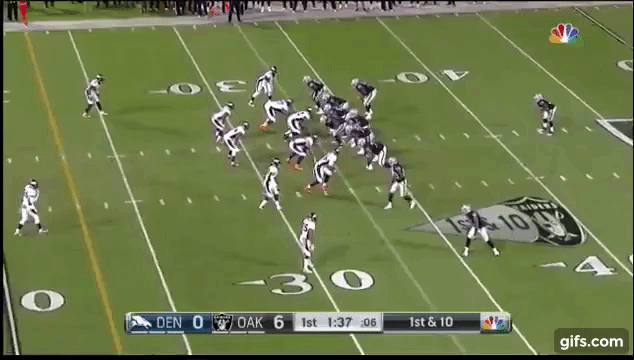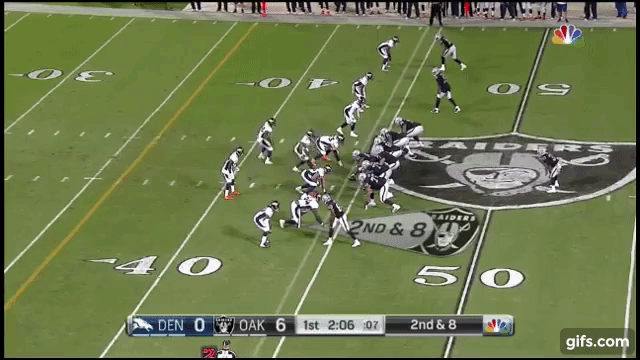© 2025 ALLCITY Network Inc.
All rights reserved.

This week for Broncos Film Room, we’re going into some of the defensive issues from Sunday night’s loss to the Oakland Raiders.
Last week on this feature, we took a look at this game from the offensive side, examining how the Raiders defense could be exploited. However, the Denver offense struggled mightily. The running game, in particular, was non-existent while the passing game was a mess early on. Oakland implemented a solid game plan and executed much better than the Broncos who at times seemed schematically outclassed.
While the offensive struggles are a narrative that we’ve covered and that will be focused on most in this game. The real story is the Broncos defense looking human for the first time in a long while.
The defense was often lacking that spark, that imposing nature that allows it to take over games and has turned the Broncos into such a devastating force over the last year and a half.
Consider this, a Raiders defense that ranked in the bottom five of the NFL in most categories coming into the week outplayed the Broncos group for most of this divisional bout. That’s not what we’re used to.
Because of this, we’re digging in to figure out what happened against the Raiders, how can it be fixed and are these issues ominous signs of the future?
Scheme
Make no mistake, at the core, this comes down to coaching. The Raiders made a key adjustment in the second drive of the game by adding a sixth offensive lineman (Denver Kirkland) in the lineup. After those initial seven offensive plays, Kirkland was in 40 of the next 69 snaps. That’s 57-percent of Oakland’s snaps, a remarkable number. It allowed Carr more protection from pressure coming from the right side, a real issue on the first drive and an area that before the game Denver seemed poised to exploit. Kirkland allowed the Raiders to dictate the game.
Smaller packages, in which the Broncos put two down lineman on the field and bring extra linebackers or defensive backs with pressure, didn’t work. Oakland was able to feast on those formations running the ball. By imposing themselves on the ground, the Raiders gained control of the clock and put the Broncos on their heels.
Putting in Kirkland on the Raiders third offensive drive proved to be crucial as Oakland methodically went downfield and got the massive touchdown to push the Raiders up 13-0.
With six offensive linemen, Carr had much more time in the pocket to move up and make timely throws while the run game got started. The Raiders made a point of dominating the right side of the line and often did so with as many as five blockers on just the right side (once you add Kirkland and a tight end).
Struggles on the interior
After analyzing the defensive holes in the two losses to the Atlanta Falcons and San Diego Chargers, we talked about some of the defensive line issues, and how Malik Jackson’s absence was undoubtedly felt. This has continued to be a problem as Denver is simply not the same dominating team in the trenches as they used to be. There were times last season when the three down lineman in the 3-4 alignment seemed to be able to stop the run on their own. Regardless of Jackson, even Sylvester Williams and Derek Wolfe aren’t getting into the opposing backfield as they were in 2016.
Part of this was having to deal with more blockers, but part of it is simply not creating the same type of push from the interior, nor shooting gaps. Jared Crick hasn’t played poorly but also hasn’t been spectacular; he had some issues on Sunday. With the loss of Wolfe, this group will be tested even further.
Williams is in a contract year and, without Darius Kilgo, Sly was the only true nose tackle that Denver had on Sunday—a reason why we saw more 4-3 alignments, surely. Williams is taking on double blocks and taking care of his gaps, but part of the issue is teammates on the second level not coming in to close secondary gaps.
The line’s issues on the interior haven’t only been with the run, the quarterback pressure from the interior has been absent. The more this occurs and the three guys up front are unable to get push up the middle, the more quarterbacks can step up and make passes avoiding the pressure off the edge. Again, issues were exploited by the scheme with the added offensive lineman but, in general, the push up the middle for Denver’s pass rush is lacking. The danger of that is that then you start to blitz more with linebackers and safeties, thus compromising some coverage responsibilities taking on much more risk.
The quick passing game
Teams have had success in avoiding the outside pass rush with shorter throws. Much of this comes down to tackling on the outside, something that Denver struggled with, especially early. The Broncos weren’t all that fundamentally sound in coverage particularly from their corners.
It, of course, must be mentioned that the Broncos were without Aqib Talib and Kayvon Webster, greatly hindering their all-world depth.
Bradley Roby, who looked like a shooting star last week against the San Diego Chargers, struggled mightily. Roby missed tackles, had some pretty bad penalties and just didn’t look sharp. It’s easy to use the Talib absence as an excuse and few defenses could handle being without one of the NFL’s best at the cornerback position, but this is still troubling. The reality is, the Broncos probably need to start considering a future without Talib sooner rather than later and struggling this much in coverage in the short-to-intermediate game is certainly an important warning sign. Lorenzo Doss also wasn’t nearly as sharp as he’d looked a week ago.
The Raiders found a way to pick on Roby often, and he wasn’t always up to the task. Derek Carr did a terrific job with his reads and has a lightning quick release with the arm strength to back it up. Even the 1985 Chicago Bears lost a game to Dan Marino and the Miami Dolphins offense. Sometimes the adversary’s just better than you, but Carr will be a problem for a while, so creating pressure on him and limiting the success of the short completions will be key in stopping him in the future.
It should be mentioned that Denver was very efficient in limiting big plays or long throws from the Oakland aerial attack. But the ability to stop the short passing game must improve.
How’s this different from the ATL and SD losses?
While the Falcons and Chargers were able to outsmart and out finesse the defense this loss was different. This wasn’t just scheme beating the Broncos, with pick plays and passes to backs motioned out in space, this was a manhandling of the world-champion defense. The adjustments aren’t as easy to make if the line isn’t getting the same push and the cornerback depth isn’t as strong as initially thought. Scheme can’t make up for everything and personnel issues could be the problem now, especially if Wolfe and Talib’s injuries keep them out for any sort of extended amount of time.
Conclusion
This loss and defensive performance brings to light some important decisions that Denver will have to make in the future. A defense without Talib is something that needs to be thought about, and the evaluation of Roby and Doss, plus other potential replacements needs to continue.
The necessary work on the defensive line appears to be even more pressing as the absence of Jackson is felt more and more. Is Gotsis the answer or does someone else need to be added in the future? What happens now when Sly Williams’ contract is up and the front three will be left with only Wolfe from the Super Bowl line?
Without being all doom and gloom, we must remind you that the defense allowed only one touchdown that wasn’t off a turnover. The two initial field goals were aided by terrible field position on offense and that even at their very worst the ‘D’ almost made a key interception with the game still in the balance at 23-13, while holding Carr below 200 passing yards.
This was a total team loss, there’s no denying it, but seeing the Orange Crush ‘D’ in such disarray Sunday in Oakland has raised some important red flags that this group will have to answer, starting with the Saints on Sunday.
Comments
Share your thoughts
Join the conversation





